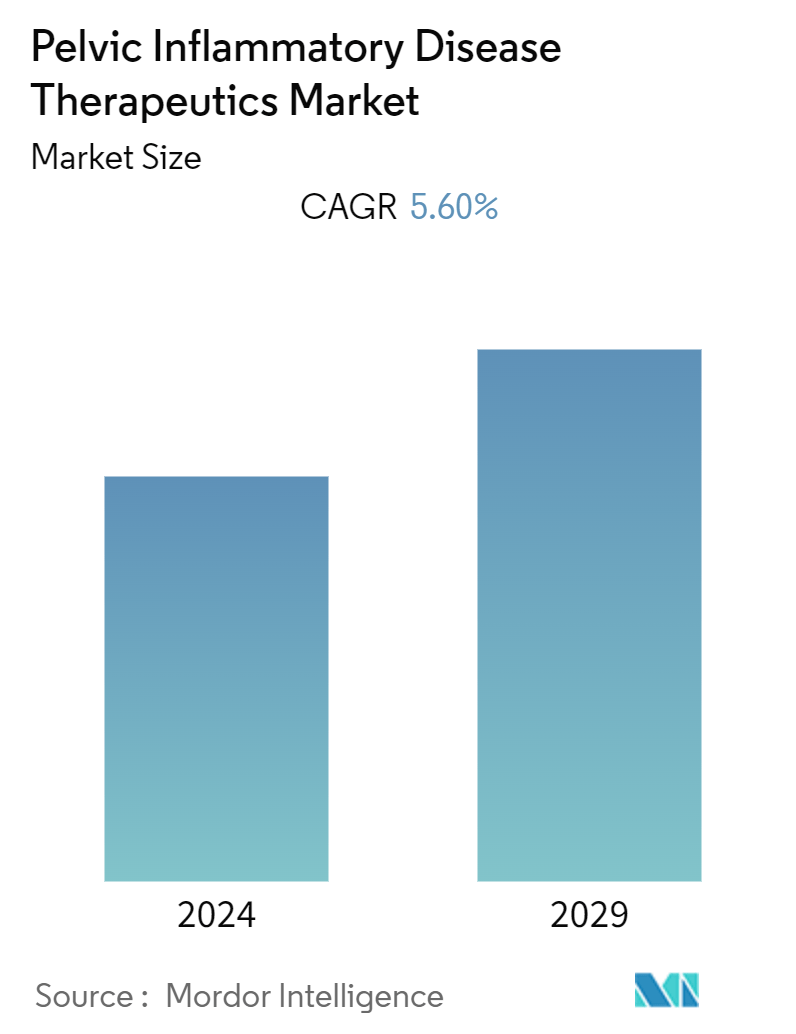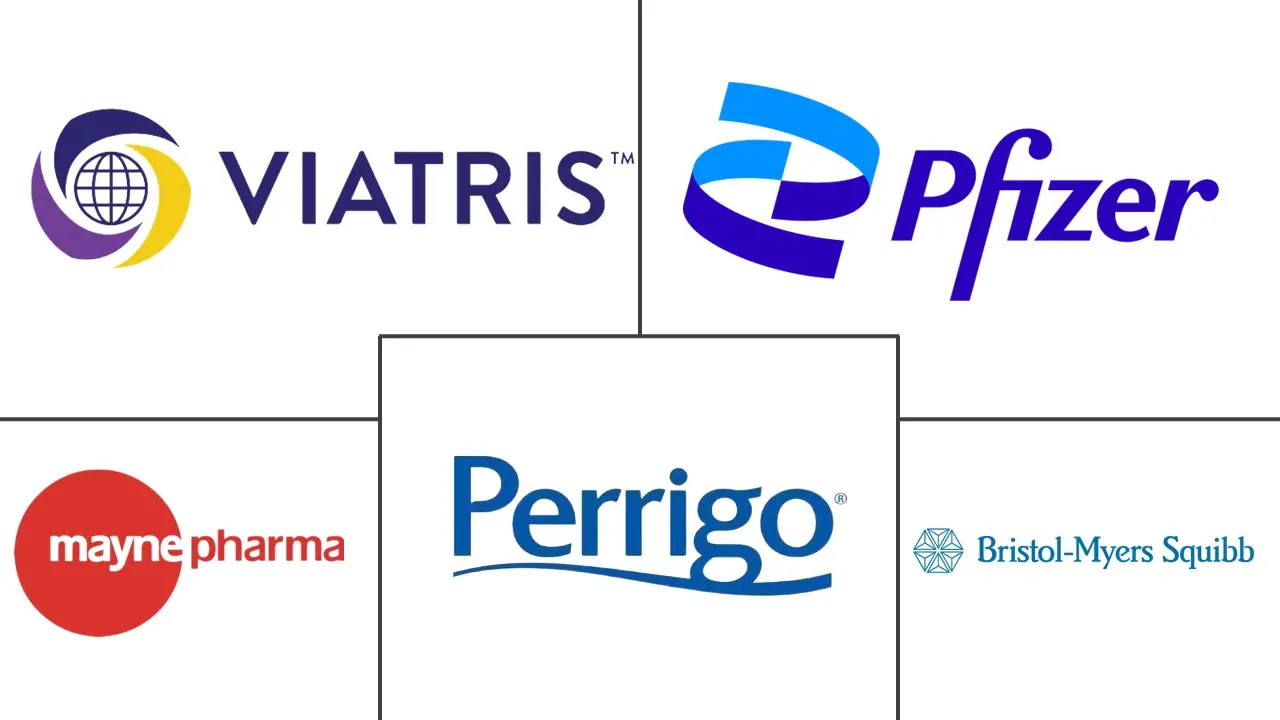Market Size of Pelvic Inflammatory Disease Therapeutics Industry

| Study Period | 2019 - 2029 |
| Base Year For Estimation | 2023 |
| CAGR (2024 - 2029) | 5.60 % |
| Fastest Growing Market | Asia Pacific |
| Largest Market | North America |
| Market Concentration | Medium |
Major Players
*Disclaimer: Major Players sorted in no particular order |
Pelvic Inflammatory Disease Therapeutics Market Analysis
The Pelvic Inflammatory Disease Therapeutics Market is expected to register a CAGR of 5.60% during the forecast period.
Factors such as the increasing prevalence of sexually transmitted diseases (STDs) and infections worldwide and the rise in healthcare awareness, along with the increasingly aging female population, are expected to boost the market’s growth during the forecast period.
The growing burden of sexually transmitted diseases (STDs) among the population globally, owing to having unprotected sex, is the key factor propelling market growth. For instance, in October 2023, the UK Health Security Agency (UKHSA) released data on sexually transmitted infections (STIs) and the chlamydia screening program. The data highlighted significant increases in diagnoses, with 392,453 new STIs, notably gonorrhea and syphilis, in 2022, with an increase of 23.8% compared to the previous year. Gonorrhea diagnoses increased to 82,592 in 2022, an increase of 50.3% compared to 54,961 cases diagnosed during the last year in England. Thus, the rising number of infectious cases among the population raises their risk of developing pelvic inflammatory diseases, fueling the demand for effective therapeutics and boosting market growth.
Similarly, preliminary National Institute of Infectious Diseases (NIID) 2023 data showed that the number of people infected with STDs hit a total of 4,370 as of April 2023. This figure greatly exceeded the 3,027 infections recorded during the same period in 2022. Thus, the increasing number of STDs, such as chlamydia and gonorrhea, can cause pelvic inflammatory diseases as they cause inflammation and infection in the pelvic organs. Hence, the demand for novel therapeutics is expected to be bolstered, propelling market growth.
Furthermore, growing government initiatives to launch various awareness programs and guidelines regarding STDs and infections related to pelvic organs raise diagnosis and screening of the condition. This is further expected to create opportunities for the high demand for effective therapeutics, augmenting the market’s growth. For instance, in June 2022, the Centers for Disease Control and Prevention recommended and released guidelines for screening sexually transmitted diseases (STDs). These guidelines aim to raise awareness about the growing global burden of STDs and the importance of screening programs. The recommendations are tailored, with specific guidelines for various demographic groups, including women, pregnant women, men who have sex with women, men who have sex with men, transgender and gender-diverse individuals, and those with HIV.
Similarly, in March 2022, the State of New Jersey's Department of Health launched the Sexually Transmitted Disease (STD) Program. The initiative aimed to combat and mitigate the repercussions of STDs in New Jersey through partner services, education, technical support, surveillance, and collaborations with local health and community entities. By enhancing disease awareness and treatment knowledge, these efforts are poised to drive the demand for PID therapeutics, thus bolstering the market’s growth during the forecast period.
Therefore, the high burden of STDs and infections among the population and growing government initiatives are expected to fuel the market’s growth during the forecast period. However, the stringent regulatory framework that delays the approval of products, expensive patented products, and severe complications associated with the medication are expected to hinder the growth of the pelvic inflammatory disease therapeutics market during the forecast period.
Pelvic Inflammatory Disease Therapeutics Industry Segmentation
As per the scope, pelvic inflammatory disease (PID) is an acute clinical condition resulting from an infection of the endometrium, fallopian tubes, and surrounding structures. This infection is typically caused by bacteria ascending from the cervix or vagina. Neisseria gonorrhoeae (N. gonorrhoeae) and Chlamydia trachomatis (C. trachomatis) are common pathogens, originating in the lower vaginal tract and then spreading to the uterus, fallopian tubes, and ovaries. Additionally, PID often transitions into a polymicrobial infection due to various endogenous bacteria in the vaginal-cervical region.
The pelvic inflammatory disease therapeutics market is segmented by drug class, route of administration, distribution channel, and geography. By drug class, the market is segmented into tetracycline, beta-lactam, macrolides, nitroimidazoles, and other drug classes. By route of administration, the market is bifurcated into oral, parenteral, and other routes of administration. By distribution channel, the market is segmented into hospital pharmacies, retail pharmacies, and online pharmacies. By geography, the market is divided into North America, Europe, Asia-Pacific, Middle East and Africa, and South America. The report offers the values (USD) for the above segments.
| By Drug Class | |
| Macrolides | |
| Tetracycline | |
| Beta-lactam | |
| Nitroimidazoles | |
| Other Drug Classes |
| By Route of Administration | |
| Oral | |
| Parenteral | |
| Other Routes of Administration |
| By Distribution Channel | |
| Hospital Pharmacies | |
| Retail Pharmacies | |
| Online Pharmacies |
| By Geography | ||||||||
| ||||||||
| ||||||||
| ||||||||
| ||||||||
|
Pelvic Inflammatory Disease Therapeutics Market Size Summary
The pelvic inflammatory disease therapeutics market is poised for growth, driven by the increasing prevalence of sexually transmitted diseases and infections globally. The rise in unprotected sexual activities has significantly contributed to the surge in STDs, which in turn elevates the risk of developing pelvic inflammatory diseases. This scenario is further exacerbated by an aging female population and heightened healthcare awareness, which collectively bolster the demand for effective therapeutics. Government initiatives aimed at raising awareness and providing guidelines for STD screening are expected to create additional opportunities for market expansion. Despite these positive growth drivers, challenges such as stringent regulatory frameworks, high costs of patented products, and complications associated with medications may impede market progress.
The market is characterized by the dominance of tetracycline and its derivatives, which are widely used due to their efficacy in treating bacterial infections. The ongoing research and clinical studies supporting the safety and effectiveness of tetracycline-class antibiotics are anticipated to enhance their adoption, thereby propelling segment growth. North America is expected to hold a significant market share, supported by the rising incidence of pelvic organ diseases and government-led health initiatives. The introduction of new therapeutics and the approval of novel drugs further contribute to market dynamics. The competitive landscape is marked by the presence of major players like Pfizer Inc., Bristol-Myers Squibb Company, and Viatris, who are actively engaging in product launches and strategic acquisitions to strengthen their market positions.
Pelvic Inflammatory Disease Therapeutics Market Size - Table of Contents
-
1. MARKET DYNAMICS
-
1.1 Market Overview
-
1.2 Market Drivers
-
1.2.1 Increasing Prevalence of STD and Infectious Diseases Across the World
-
1.2.2 Rise in Healthcare Awareness along with the Increasing Aging Female Population
-
-
1.3 Market Restraints
-
1.3.1 Stringent Regulatory Framework that Delays the Approval of Products
-
1.3.2 Expensive Patented Products and Severe Complications Associated with the Medication
-
-
1.4 Porter's Five Forces Analysis
-
1.4.1 Threat of New Entrants
-
1.4.2 Bargaining Power of Buyers/Consumers
-
1.4.3 Bargaining Power of Suppliers
-
1.4.4 Threat of Substitute Products
-
1.4.5 Intensity of Competitive Rivalry
-
-
-
2. MARKET SEGMENTATION (Market Size by Value - USD)
-
2.1 By Drug Class
-
2.1.1 Macrolides
-
2.1.2 Tetracycline
-
2.1.3 Beta-lactam
-
2.1.4 Nitroimidazoles
-
2.1.5 Other Drug Classes
-
-
2.2 By Route of Administration
-
2.2.1 Oral
-
2.2.2 Parenteral
-
2.2.3 Other Routes of Administration
-
-
2.3 By Distribution Channel
-
2.3.1 Hospital Pharmacies
-
2.3.2 Retail Pharmacies
-
2.3.3 Online Pharmacies
-
-
2.4 By Geography
-
2.4.1 North America
-
2.4.1.1 United States
-
2.4.1.2 Canada
-
2.4.1.3 Mexico
-
-
2.4.2 Europe
-
2.4.2.1 Germany
-
2.4.2.2 United Kingdom
-
2.4.2.3 France
-
2.4.2.4 Italy
-
2.4.2.5 Spain
-
2.4.2.6 Rest of Europe
-
-
2.4.3 Asia-Pacific
-
2.4.3.1 China
-
2.4.3.2 Japan
-
2.4.3.3 India
-
2.4.3.4 Australia
-
2.4.3.5 South Korea
-
2.4.3.6 Rest of Asia-Pacific
-
-
2.4.4 Middle East and Africa
-
2.4.4.1 GCC
-
2.4.4.2 South Africa
-
2.4.4.3 Rest of Middle East and Africa
-
-
2.4.5 South America
-
2.4.5.1 Brazil
-
2.4.5.2 Argentina
-
2.4.5.3 Rest of South America
-
-
-
Pelvic Inflammatory Disease Therapeutics Market Size FAQs
What is the current Pelvic Inflammatory Disease Therapeutics Market size?
The Pelvic Inflammatory Disease Therapeutics Market is projected to register a CAGR of 5.60% during the forecast period (2024-2029)
Who are the key players in Pelvic Inflammatory Disease Therapeutics Market?
Pfizer Inc, Mayne Pharma, Bristol‑Myers Squibb Company, Viatris and Perrigo Company plc are the major companies operating in the Pelvic Inflammatory Disease Therapeutics Market.

